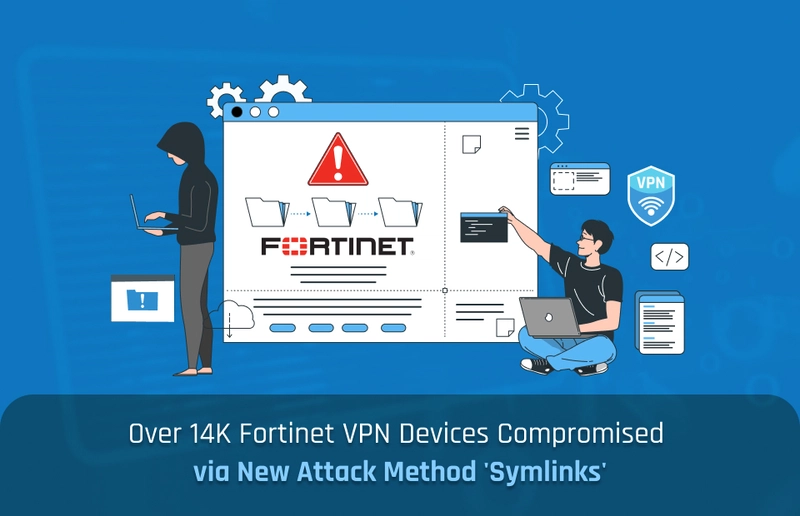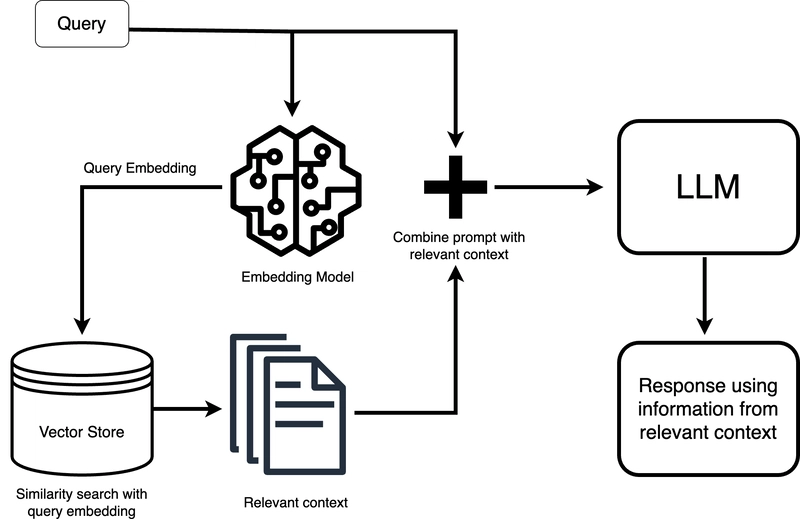Stealthy FortiGate Backdoor: SSL-VPN Symlink Exploit Bypasses Patches
Fortinet, a prominent cybersecurity firm, has issued a critical advisory warning users of a newly discovered exploit that allows attackers to maintain unauthorized, read-only access to FortiGate devices, even after security patches have been applied. The vulnerability stems from a symbolic link (symlink) abuse within the SSL-VPN feature, enabling stealthy access and posing a major security risk. The Exploit This attack leverages symbolic links (symlinks)-shortcuts that reference other files or directories. In Unix-based systems, symlinks are commonly used for convenience, allowing programs and users to access resources indirectly. However, threat actors have found a way to turn this feature into a stealthy backdoor. Here's the breakdown: Attackers first exploit older, well-documented vulnerabilities in FortiGate devices, such as: CVE-2022-42475 CVE-2023-27997 CVE-2024-21762 These vulnerabilities allow for unauthenticated remote code execution, granting full control of the device. Although Fortinet has issued patches, attackers are using these flaws as an entry point. Once inside, they create symlinks within the SSL-VPN's directory structure, particularly in the folder designated for VPN language files. These locations are user-writable and often escape the attention of standard security tools. The symlinks are then directed toward sensitive configuration files, giving the attacker persistent, read-only access to critical data. Notably, this access remains intact even after the original vulnerabilities are patched-making it a long-term threat that's hard to detect. Why It's So Hard to Detect This exploit is particularly dangerous due to its stealthy nature. The symlinks are placed in legitimate-looking locations, making them difficult to detect. Since FortiGate appliances typically lack endpoint detection and response (EDR) agents, malicious files or backdoors can easily go unnoticed. The use of read-only access also helps attackers remain under the radar, as they're not making changes that might trigger alerts. They simply monitor and collect critical data. Who Is at Risk? Devices affected by this exploit are limited to those with SSL-VPN functionality enabled. Organizations in critical infrastructure sectors have already reported suspicious activity linked to this vulnerability. Those who do not use SSL-VPN features remain unaffected. Impact and Potential Damage While the attacker's access is technically limited to "read-only," the implications are significant. By accessing: User credentials Network configurations Security and access policies Internal topology maps …the attacker can build a blueprint for lateral movement, launch phishing campaigns, or prepare future attacks with elevated privileges. Indicators of Compromise (IOCs) Fortinet has identified the following red flags: Unauthorized symlinks in directories associated with VPN language files. Symlinks connecting user-accessible file systems to the root-level configuration files. System administrators should actively scan for these artifacts, especially in environments where the SSL-VPN feature is active. Fortinet's Recommendations To mitigate the risk and limit exposure, Fortinet recommends: Update antivirus and IPS signatures to the latest versions, as Fortinet has rolled out specific detection patterns for this attack. Scan and remove malicious symlinks if present on FortiGate devices. Reset all potentially exposed passwords and secrets. Audit SSL-VPN logs and activity for unusual behavior. Key Takeaways This exploit is a clear example of how attackers adapt and evolve. Even after applying patches for known vulnerabilities, your systems may remain vulnerable if proper post-patch auditing and monitoring aren't in place. Organizations relying solely on patch management may be operating under a false sense of security. Persistent threats like these require a multi-layered defense strategy that includes: Regular system audits Continuous monitoring for IOCs Deactivation of unused VPN features Deployment of advanced EDR tools Stay Ahead of Threats Cyberattacks are becoming more sophisticated and persistent. The FortiGate symlink exploit proves that attackers don't need full control-they just need a way in. If left unchecked, even read-only access can pave the way for catastrophic breaches. Take action now. Secure your FortiGate devices, review your configurations, and adopt proactive threat monitoring. Don't wait for a breach to remind you of what could've been prevented. Need help hardening your network? Our certified security experts at SiteLock specialize in vulnerability detection, response, and long-term security solutions. Let's secure your infrastructure-before it's too late.

Fortinet, a prominent cybersecurity firm, has issued a critical advisory warning users of a newly discovered exploit that allows attackers to maintain unauthorized, read-only access to FortiGate devices, even after security patches have been applied. The vulnerability stems from a symbolic link (symlink) abuse within the SSL-VPN feature, enabling stealthy access and posing a major security risk.
The Exploit
This attack leverages symbolic links (symlinks)-shortcuts that reference other files or directories. In Unix-based systems, symlinks are commonly used for convenience, allowing programs and users to access resources indirectly. However, threat actors have found a way to turn this feature into a stealthy backdoor.
Here's the breakdown:
Attackers first exploit older, well-documented vulnerabilities in FortiGate devices, such as:
- CVE-2022-42475
- CVE-2023-27997
- CVE-2024-21762
These vulnerabilities allow for unauthenticated remote code execution, granting full control of the device. Although Fortinet has issued patches, attackers are using these flaws as an entry point.
Once inside, they create symlinks within the SSL-VPN's directory structure, particularly in the folder designated for VPN language files. These locations are user-writable and often escape the attention of standard security tools.
The symlinks are then directed toward sensitive configuration files, giving the attacker persistent, read-only access to critical data. Notably, this access remains intact even after the original vulnerabilities are patched-making it a long-term threat that's hard to detect.
Why It's So Hard to Detect
This exploit is particularly dangerous due to its stealthy nature. The symlinks are placed in legitimate-looking locations, making them difficult to detect. Since FortiGate appliances typically lack endpoint detection and response (EDR) agents, malicious files or backdoors can easily go unnoticed.
The use of read-only access also helps attackers remain under the radar, as they're not making changes that might trigger alerts. They simply monitor and collect critical data.
Who Is at Risk?
Devices affected by this exploit are limited to those with SSL-VPN functionality enabled. Organizations in critical infrastructure sectors have already reported suspicious activity linked to this vulnerability. Those who do not use SSL-VPN features remain unaffected.
Impact and Potential Damage
While the attacker's access is technically limited to "read-only," the implications are significant. By accessing:
- User credentials
- Network configurations
- Security and access policies
- Internal topology maps
…the attacker can build a blueprint for lateral movement, launch phishing campaigns, or prepare future attacks with elevated privileges.
Indicators of Compromise (IOCs)
Fortinet has identified the following red flags:
- Unauthorized symlinks in directories associated with VPN language files.
- Symlinks connecting user-accessible file systems to the root-level configuration files.
- System administrators should actively scan for these artifacts, especially in environments where the SSL-VPN feature is active.
Fortinet's Recommendations
To mitigate the risk and limit exposure, Fortinet recommends:
- Update antivirus and IPS signatures to the latest versions, as Fortinet has rolled out specific detection patterns for this attack.
- Scan and remove malicious symlinks if present on FortiGate devices.
- Reset all potentially exposed passwords and secrets.
- Audit SSL-VPN logs and activity for unusual behavior.
Key Takeaways
This exploit is a clear example of how attackers adapt and evolve. Even after applying patches for known vulnerabilities, your systems may remain vulnerable if proper post-patch auditing and monitoring aren't in place.
Organizations relying solely on patch management may be operating under a false sense of security. Persistent threats like these require a multi-layered defense strategy that includes:
- Regular system audits
- Continuous monitoring for IOCs
- Deactivation of unused VPN features
- Deployment of advanced EDR tools
Stay Ahead of Threats
Cyberattacks are becoming more sophisticated and persistent. The FortiGate symlink exploit proves that attackers don't need full control-they just need a way in. If left unchecked, even read-only access can pave the way for catastrophic breaches.
Take action now. Secure your FortiGate devices, review your configurations, and adopt proactive threat monitoring. Don't wait for a breach to remind you of what could've been prevented.
Need help hardening your network? Our certified security experts at SiteLock specialize in vulnerability detection, response, and long-term security solutions. Let's secure your infrastructure-before it's too late.










































































































































































![[The AI Show Episode 144]: ChatGPT’s New Memory, Shopify CEO’s Leaked “AI First” Memo, Google Cloud Next Releases, o3 and o4-mini Coming Soon & Llama 4’s Rocky Launch](https://www.marketingaiinstitute.com/hubfs/ep%20144%20cover.png)


















































































































![[DEALS] The All-in-One Microsoft Office Pro 2019 for Windows: Lifetime License + Windows 11 Pro Bundle (89% off) & Other Deals Up To 98% Off](https://www.javacodegeeks.com/wp-content/uploads/2012/12/jcg-logo.jpg)





































![Is this too much for a modular monolith system? [closed]](https://i.sstatic.net/pYL1nsfg.png)






















































































































_Andreas_Prott_Alamy.jpg?width=1280&auto=webp&quality=80&disable=upscale#)
































































































![What features do you get with Gemini Advanced? [April 2025]](https://i0.wp.com/9to5google.com/wp-content/uploads/sites/4/2024/02/gemini-advanced-cover.jpg?resize=1200%2C628&quality=82&strip=all&ssl=1)













![Apple Shares Official Trailer for 'Long Way Home' Starring Ewan McGregor and Charley Boorman [Video]](https://www.iclarified.com/images/news/97069/97069/97069-640.jpg)
![Apple Watch Series 10 Back On Sale for $299! [Lowest Price Ever]](https://www.iclarified.com/images/news/96657/96657/96657-640.jpg)
![EU Postpones Apple App Store Fines Amid Tariff Negotiations [Report]](https://www.iclarified.com/images/news/97068/97068/97068-640.jpg)
![Apple Slips to Fifth in China's Smartphone Market with 9% Decline [Report]](https://www.iclarified.com/images/news/97065/97065/97065-640.jpg)




































































































































